MAGNIFICAT MEAL TIMELINE
1953 (June 17): Debra Burslem was born in Melbourne.
1973: Debra Burslem married Gordon Geileskey.
1992 (some date to 1986 or 1990): The Magnificat Meal Movement (MMM) began in Melbourne.
1993: The Geileskeys’ real estate business collapsed; they relocated to Toowoomba (Queensland).
1993: The Magnificat Meal Movement arrived in Toowoomba (Queensland). The group soon moved to nearby Helidon.
1995 (December): The Geileskeys moved into “Shrine of Mary” at Mary’s Mount, Helidon.
1996 (February): MMM families begin relocating to Mary’s Mount.
1996 (May 17): Bishop Morris wrote to Priests indicating the MMM had no official church approval.
1997: Debra Geileskey clashed with the Parish Priest at Helidon.
1997 (July 1): Bishop Morris issued a statement reiterating his earlier letter to priests.
1997 (September 1): Bishop of Toowoomba, William Morris, established a Diocesan Commission of Enquiry to investigate the Magnificat Meal Movement.
1997 (November): The Commission of Enquiry into the Magnificat Meal Movement completed its first report.
1998 (October): The Commission of Enquiry into the Magnificat Meal Movement completed its second report.
1998: An investigation was conducted by the Office of Consumer Affairs of the Queensland Department of Justice into allegations regarding use of monies for religious purposes. There were no negative findings due to insufficient evidence.
1999 (February 11). Bishop Morris issued an episcopal declaration censuring MMM.
1999 (June): Debra and Gordon Geilesky separated. Gordon threatened to evict Debra and her followers from convent and denounced his wife as fraud. Debra issued a domestic violence order against husband.
1999 (October): Former member Wal Maggs self-published a critical book, An End Times Tragedy: Debra Geileskey and the Magnificat Meal Movement.
1999 (October 13): A judgement in the legal dispute over MMM property was handed down by Justice John Muir in the Supreme Court of Queensland.
2003: Bishop William Morris wrote to priests in the Diocese of Toowoomba reiterating the status of the Magnificat Meal Movement.
2007: Debra Geilesky relocated to Vanuatu.
FOUNDER/GROUP HISTORY
The Magnificat Meal Movement International (MMM) originated in Melbourne (Victoria, Australia) around 1992 (though some sources claim as early as 1986) as a loose-knit set of prayer groups affiliated with strands of the Catholic Charismatic Renewal (CCR) which sought to encourage increased devotion to the Blessed Virgin Mary and the Eucharist. In addition to its devotional concerns, the group also 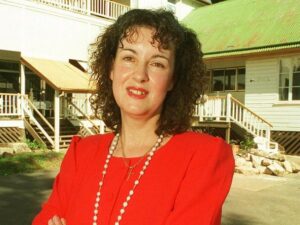 distributed a series of, at times, apocalyptic private revelations allegedly received by the group’s founder Debra Burslem (b.1953), in the form of diaries entitled What Might God Say to Me Today…in Australia. [Image at right]
distributed a series of, at times, apocalyptic private revelations allegedly received by the group’s founder Debra Burslem (b.1953), in the form of diaries entitled What Might God Say to Me Today…in Australia. [Image at right]
It is difficult to unravel the early part of Debra Burslem’s biography as her own writings are often contradicted by the information uncovered by journalists and ecclesiastical investigations. Debra Burslem (later Debra Geileskey) was born in Melbourne in 1953 and educated in local parochial Roman Catholic schools and eventually attended teacher training college in the 1970s. She married Gordon Geileskey at around age twenty. It was around this time that she embarked upon a career as a schoolteacher during the late 1970s and early 1980s in the Catholic education system in Victoria, rising to the level of an acting principal before quitting the teaching profession. Debra Geilesky later claimed she was “black-banned” for a close spiritual association with a priest, although this was denied by the priest in question. Other sources, obtained by a later ecclesiastical investigation, suggested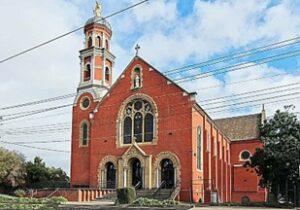 that Debra was overly disciplinarian in her treatment of children. Following leaving the teaching profession, Debra Geilesky went into the real estate industry with her then husband, Gordon. The couple’s fortunes were not positive, and according to contemporary reports they were near bankruptcy by the mid-1990s. According to media reports it was around this time that Debra became increasingly involved in the Catholic Charismatic Renewal, through the parish of Our Lady Help of Christians in East Brunswick, Melbourne. [Image at right]
that Debra was overly disciplinarian in her treatment of children. Following leaving the teaching profession, Debra Geilesky went into the real estate industry with her then husband, Gordon. The couple’s fortunes were not positive, and according to contemporary reports they were near bankruptcy by the mid-1990s. According to media reports it was around this time that Debra became increasingly involved in the Catholic Charismatic Renewal, through the parish of Our Lady Help of Christians in East Brunswick, Melbourne. [Image at right]
Debra Geileskey became increasingly influential in this milieu, much to the chagrin of the parish priest, who claimed she began to organise against him. This was the first of a series of conflicts between Geileskey and the parochial Catholic clergy over the succeeding years. It was around this time, in 1993, that Debra Geileskey claimed that she was given a “miraculous sign,” and she and her husband relocated to Toowoomba in Southeast Queensland. Upon arrival the group continued its activities under the auspices of prayer groups in the Holy Name Parish in Toowoomba. Once again tensions over oversight emerged with the parish priest, with Geileskey and her followers decamping to Helidon and purchasing a disused convent called Mary’s Mount, located behind the parish church of St Joseph’s.
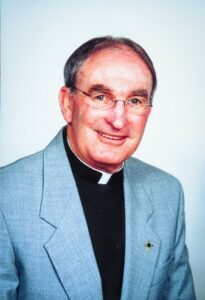
Over the ensuing years the group became an increasingly controversial presence within the Diocese of Toowoomba. While initially Bishop William Morris [Image at right] had permitted the group to operate in his diocese, he had not given any official approval and was awaiting further documentation. During this early period Bishop Morris had received both Debra and Gordon Geileskey in his office to discuss the movement. Concerns were raised, however, when the movement began publishing Debra’s diaries, which contained various bizarre claims about the Church. Over time Debra began to claim that the Church, at the instigation of the Devil, was persecuting her.
In mid-1996 Bishop Morris responded to these claims in a first letter to priests in his diocese in which he noted that questions had been raised regarding the movement’s status in the Church, its orthodoxy, its alleged private revelations and miracles, and its financial activities. Distancing himself from the group, Bishop Morris concluded the letter by noting that “from this moment in time until further notice the Magnificat Meal Movement has no standing within this Diocese.” Bishop Morris, however, left the door open to the group.
After a year, when it became clear that Debra was not interested in rapprochement, Bishop Morris issued a second public statement in which he reiterated his earlier letter:
I stated then and I state again now that the Magnificat Meal Movement is a private movement sponsored and foundered by Debra Geileskey. It is of Debra and has absolutely nothing to do with the Catholic Church. There is no Church approval of the Magnificat Meal Movement or for the alleged private revelations and visions of Debra. Those who attend and participate in the practices of the Magnificat Meal Movement do so as private individuals and not as members of the Catholic Church.
Bishop Morris repeated his warnings of the previous May, noting that there “is clear evidence of the half-truths and inconsistencies in statements and reports made by the Magnificat Meal Movement,” and, moreover, that “The Magnificat Meal Movement uses traditional Catholic practices to entrap people into a sect or cult that is not Catholic.” Morris considered the movement to be damaging to its members, concluding that:
The confusion and the hurt surrounding Debra and her movement saddens me for there have been many who through traditional devotion to Eucharist and to Mary have experienced conversion of heart and deepened their faith in the Risen Lord.
Unfortunately because of the half-truths, the inconsistencies and in some instances the lack of orthodoxy concerning aspects of statements made and practices performed, the Magnificat Meal Movement places itself outside the catholic Church.
Mary’s Mount, however, continued to attract a significant influx of pilgrims for First Saturday devotions and other events, drawing busloads from as far away as Ireland. Meanwhile, the Magnificat Meal Movement increased its property holdings around Helidon. Debra also began to collect a considerable amount of funds toward plans to build a Basilica at Mary’s Mount. Followers later claimed that these donations were obtained under false pretences. Investigations by Australian regulatory authorities continued until as recently as 2016.
With the sizeable number of pilgrims continuing to attend First Saturday devotions in Helidon, and the influx of supporters living at Mary’s Mount, in September 1997 Bishop Morris established a commission to investigate the Magnificat Meal Movement, following the (then classified) norms set down by the Vatican Congregation for the Doctrine of the Faith for investigating alleged apparitions. This commission produced two reports, and subsequently consulted with the Congregation for the Doctrine of the Faith on further actions. Debra was expressly invited to participate, but refused, later claiming not to have received an invitation. The findings of the commission were negative. Its final report recommended a strategy of not provoking further controversy and simply reaffirming the position already stated by Bishop Morris in 1996. More importantly, the final report recommended providing both Eucharistic and Marian devotional outlets within the diocese, as well as offering psychological and spiritual support for those who decided to leave the movement. To this end, Bishop Morris issued a Declaration on February 11, 1999, in which he stated:
On the basis of all the information available it can only be concluded that the alleged apparitions associated with the Magnificat Meal Movement are devoid of any supernatural origin. The writings published by the Movement itself also lead to the inevitable conclusion that it neither has, nor desires, any place in the Catholic Church.
Moreover, Bishop Morris quoted the response of the Secretary of the Congregation for the Doctrine of the Faith who noted, among other things, that:
There is an obvious lack of due respect and obedience to legitimate authority and a disregard for Church discipline. It is misleading, to say the least, that these attitudes should be presented as inspired by Our Blessed Lady. None of this can come from a good source…All of this constitutes a clear danger to many good people who may be lead away from proper obedience and loyalty to the Church.
Meanwhile, as the turn of the millennium fast approached, the group’s behaviour became increasingly concerning to authorities. In April 1999, Debra together with fourteen members of the movement pleaded guilty to disturbing a worship service at St Joseph’s Church in Helidon. Soon after authorities began to investigate what they feared were plans for a mass suicide by members of the group. The same year also witnessed attempts by Debra’s estranged husband Gordon to evict members from the group’s property at Mary’s Mount and widespread media coverage including two nationally broadcast documentaries Slaves of the Eucharist and Two Roads to Helidon. No mass suicide took place and following the turn of the millennium the group has largely faded into obscurity, only occasionally popping up as part of periodic media exposés.
In 2003, in a final public comment on the matter, Bishop Morris reiterated his earlier statements and warned priests of the need for permission to celebrate the sacraments within his diocese. This letter also noted the need to pastorally care and pray for those within the group and those who choose to leave. In this letter Bishop Morris was emphatic that he considered the group a “cult,” noting:
Throughout the world there are many similar cult like movements which have caused great distress to individuals and families because they take away people’s freedom to think for themselves. Some members realising this have accepted the invitation of the Church to move away from this cult.
After this time the movement’s activities have attracted far less attention, outside of the occasional cult exposé stories following a series of further defections of key members over the ensuing years. Since 2007, the group’s founder has been resident in the island nation of Vanuatu and the group’s only public presence appears to be online through its website.
DOCTRINES/BELIEFS
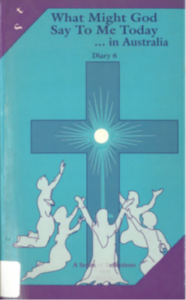
Several volumes of What Might God Say to Me Today…in Australia are held in the National Library of Australia. [Image at right] In addition to this are the statements of Bishop Morris and various analyses undertaken by scholars. Other helpful resources include a dissertation by Irish cult watcher Mike Garde and a self-published book by former member, Wal Maggs, entitled An End Times Tragedy.
In general, the Magnificat Meal Movement initially shared the belief structures common to many of the Marian apparitional movements which have periodically emerged in Roman Catholicism since the nineteenth century. In terms of specific emphases, one finds many of the features of these movements including Eucharistic adoration, devotions to Mary through prayer and consecrations, warnings against social sin, eschatological tinged language, warnings of natural disasters, and calls to repentance. Also common in the Magnificat Meal Movement’s private revelations were attacks on the local clergy and vast conspiracy theories regarding wider corruption within the Church.
Our Spirit is upon this land, redeeming and renewing as never before.
O Spirit call forth those the Father has chosen to go out into the harvest.
The harvest is ripe, Father. My suffering is freely given
My distress calls upon My fellow sufferers.
To repair the wounds of sin in this land.
O Father You are glorified through this resounding love.
Australia – receive love.
The Father and the Son breath the Spirit of love upon you.
Be made one with love, in love and through love.
O Southern land, so desolate in the filth of your sin.
I will gather you up. I have suffered for your salvation.
From this filth and squalor (of sin) that you have become, I will remake you to shine like a precious jewel in the Father’s crown. (What Might God Say to Me Today…in Australia Diary 6, 6 July 1992).
The group’s relationship with the institutional Roman Catholic Church, as suggested by the history above, has been fraught from the outset for both organizational and ideological reasons which are commonly found across the wider Marian apparition milieu. For example, at various times the group has flirted with Catholic traditionalism, and its approach to the Second Vatican Council has been ambivalent, fluctuating between affirming or condemning the Council depending largely on the whims of the leadership. Similarly, at various stages the Magnificent Meal Movement has sought to align itself with various religious bodies both within a Catholic milieu and further afield. During he late 1990s, for example, Burslem attempted to align herself with dissident traditionalists from the Society of St Pius X (SSPX). However, the Society (traditionally skeptical regarding private revelations) was not receptive to this and concluded by suggesting that an examination could go much deeper, that:
Suffice it to say that, with the study made so far, there are enough proofs to conclude that the Magnificat Meal Movement cannot come from God. Moreover it certainly leads to Protestantism by its Protestant approach to the Bible, to the Holy Eucharist, and by by-passing the submission to the Holy Catholic Church (Couture 2001).
Burslem made similar approaches to the Melkite Eparchy (who similarly rejected her overtures) and, according to one former member, local Seventh-Day Adventist congregations. Evidence suggests that these shifting emphases appear to follow the whims of the leadership.
MMM was confronted by the tabloid television program A Current Affair in Vanuatu in early 2015. Since that time it has become far more difficult to trace the Magnificat Meal Movement’s shifting belief system through its seemingly erratic online development through its website and its presence in Australia. It is rare for a group to receive the kind of media or public attention that MMM has garnered throughout the 1990s and early 2000s. MMM is now only discussed when former members are interviewed in the media.
More recently, the group’s website and YouTube channel have become largely an output for the occasional musings and personal interests of Burslem. They comprise a pastiche of New Age healing mixed with a veneer of eclectic Christian imagery, and some recordings of Christian hymns, with an occasional hint of the group’s earlier apocalyptic emphasis and conspiracy theories. Indeed, there is little today to distinguish the Magnificat Meal Movement from other wellness blogs, and so far as can be surmised from this online presence it is unclear whether the movement continues to have any real offline presence.
RITUALS/PRACTICES
As with its belief system, much of the Magnificat Meal Movement’s original ritual repertoire is drawn from traditional Roman Catholic practices. From the outset the group focused on devotional piety, in particularly Eucharistic devotion; indeed, the group members often referred to themselves as the “Slaves of the Eucharist.” The group listed eight stated aims in a pamphlet entitled “Come Join the Pilgrimage” issued in September 1998:
To participate in the Mission of the Church for the salvation of souls.
To promote and encourage Adoration of Jesus Christ, truly present in the Blessed Sacrament.
To foster evangelization and a more widespread opportunity for Adoration of Jesus Christ, by encouraging members to act as Missionaries of the Eucharist, to personally (sic.) Adoration and awareness of our God.
To promote fidelity to, and to live in conformity with, the authentic teaching authority of Christ, as expressed through His Church and His Vicar on earth.
To promote and foster devotion to Christ, through the Blessed Virgin Mary, in accordance with the traditions of the Church and the teaching of Chapter Eight of Vatican II document, Lumen Gentium, and to encourage the daily recitation of the Rosary as recommended by every Pope holding office this century.
To encourage First Saturday devotions in reparation for our personal sins and the sins of the world, as approved by Holy Mother Church.
To distribute the Icon entitled Mary, Co-Redemptrix; Mediator of All Graces and Advocate, to explain its symbolism and to legitimately participate in efforts, both prayerfully and actively, for the Church to declare, as a Dogma of Faith, that Mary is Co-Redemptrix, Mediatrix of All Graces and Advocate. By this (sic) means we pray that Jesus our King may come to reign in all hearts through the Motherly intercession of Mary.
To welcome all persons of good will into the presence and teaching of the Lord.
While many of these aims were, by mainstream Catholic standards, uncontroversial, the group’s advocacy of Mary as Co-Redemptrix, Mediatrix, and Advocate was controversial, especially after 1999.
In terms of behavioral norms, the Magnificat Meal Movement exhibited many behaviors like other conservative Catholic groups. According to former members, who have become a major source of information, the group restricted clothing options for the purposes of modesty. Followers were not permitted to wear shorts or t-shirts. Members were banned from reading magazines. Neither CDs nor radio were permitted. Other practices were more idiosyncratic. Former members have spoken of 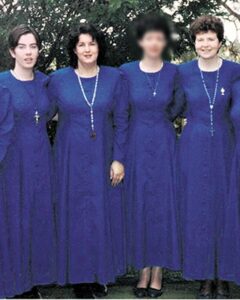 restrictions on Christmas trees and on the celebration of birthdays, Mother’s Day, and even Easter. Within the group’s community, followers were encouraged to tithe to the movement, often in the form of cash, and to work on its properties. The group was conspicuous for its long blue robes or dresses which were worn both in the cloister and in the wider community. [Image at right]
restrictions on Christmas trees and on the celebration of birthdays, Mother’s Day, and even Easter. Within the group’s community, followers were encouraged to tithe to the movement, often in the form of cash, and to work on its properties. The group was conspicuous for its long blue robes or dresses which were worn both in the cloister and in the wider community. [Image at right]
Following the 1999 Declaration of Bishop Morris, the trajectory of the group’s rituals and practices has become significantly more difficult to trace. According to former members, the group’s severing of ties with the Catholic Church appears to have led to the abandonment of the devotional emphases of earlier times and a significant number of members left and were reintegrated into the Catholic Church. Mainstream.
ORGANIZATION/LEADERSHIP
While there is some dispute regarding who the founder of the Magnificat Meal Movement was (one article suggests the Magnificat Meal Movement was founded by someone else), the group never developed a clear leadership or organizational structure outside of the charismatic leadership of Debra Geileskey. While the group produced several ephemeral documents outlining aspects of its beliefs, there is far less information available about its organization. According to some sources the group operated as a company Our Lady’s Mount Pty Ltd, which was registered between 1995 and 2019; however, the exact relationship between this company and the movement is not clear and at one stage legal action took place between the two entities. This confusion between the two entities was noted in the Supreme Court of Queensland in 1999, where Justice John Muir observed that:
Of the three directors of OLM, Mrs Geileskey was the one most actively involved in the management of its day to day financial affairs. She was also the person who had the most central role in the management of the Movement’s financial affairs.
Moreover, Justice Muir found that:
The complexity of the legal issues for determination in this matter arises, to a considerable degree, from the fact that the directors of OLM and Magnificat Meal have tended to act in disregard of legal entities and concepts when dealing with the large sums of money donated for the purposes of the Movement.
While Justice Muir was not asked to rule on these specific issues, his ruling suggested that there was perhaps further legal action to be taken regarding Geileskey’s fiduciary obligations and accountability, noting that “Mrs Geileskey was a director of Magnificat Meal and OLM and the guiding force of Magnificat Meal at all times.” Indeed, this was not the first time this was raised, and earlier concerns were raised by the Catholic Church about the lack of accountability outside of Geileskey and her immediate family and this increased tensions with the mainstream Church. In its second report, submitted to the Congregation for the Doctrine of the Faith a year earlier in 1998, the Diocesan Commission concluded that it “finds unanswered questions regarding financial accountability and has concerns that every activity of the Movement is seemingly accompanied by a range of profit-making activities.” Moreover, in the group’s post-Roman Catholic phase it is difficult to identify any other figures involved other than Geileskey.
ISSUES/CHALLENGES
As the history above indicates, from the outset the group has been the subject of a series of both internal and external controversies. These are best divided into ecclesiastical, legal, and civil disputes. Perhaps the most repeated controversies have related to the group’s status in relation to the Roman Catholic Church. Like numerous other Marian apparition movements to emerge in the past century the Magnificat Meal Movement has had an ambivalent relationship with the hierarchy of the Church. As noted above, initially Bishop Morris sought to take a pastoral line with the group and met with Gordon and Debra Geileskey. This relationship soured, however, when questions were raised and Debra became increasingly scathing of individual clergy, making various unsubstantiated claims about individual priests. This led to an official Diocesane Commission, which drew the ultimate conclusion that:
After examining all the written and oral evidence, this Commission can find nothing to substantiate her claims of supernatural revelations and apparitions, nor of miraculous events associated with them.
Over the years MMM sought to adopt a series of strategies to overcome this including attempts to bypass the authority of the local bishop through alliance with either canonically irregular groups or through Eastern Rite Catholic Churches.
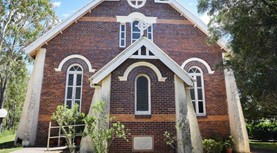
In terms of legal disputes, the Magnificat Meal Movement, its members, and its associated legal entities have been involved in a series of issues ranging from disturbing worship services, to child custody and property disputes. Moreover, the group’s activities in the town of Helidon have resulted in a considerable amount of antipathy in the wider community, most clearly evident in the documentaries Slaves of the Eucharist and The Road to Helidon. [Image at right]
While the circumstances of Debra Geileskey’s move to Vanuatu has remained a source of speculation, with some suggesting this was to avoid potential legal proceedings against her. Meanwhile, the group appears to be in terminal decline. Moreover, its alienation from its Catholic moorings and abandonment of all the Catholic devotional practices has cut-off its only real source for the recruitment of future members. It remains controversial in Vanuatu and the subject of ongoing scrutiny by former members.
IMAGES
Image #1: Debra Burslem Geileskey.
Image #2: Our Lady Help of Christians Parish in East Brunswick, Victoria.
Image #3: Bishop William Morris of Toowoomba.
Image #4: Cover of What Might God Say to Me Today…in Australia.
Image #5: Magnificat Meal Movement Members.
Image #6: St Joseph’s Catholic Church, Helidon, Queensland.
REFERENCES
Couture, Daniel. 2001. “The Magnificat Meal Movement – An Assessment.” SSPX Newsletter of the District of Asia, January-June. Accessed from https://sspxasia.com/Newsletters/2001/Jan-Mar/magnificat-meal-movement.htm on 15 March 2024.
Dobbyn, Paul. 2015. “Warning on cults.” The Catholic Leader, April 21. Accessed from https://catholicleader.com.au/news/warning-on-cults/ on 15 March 2024.
Doherty, Bernard. 2017. “Marian Arks Cut Adrift: The Post-Roman Catholic Development of Two Australian Marian Apparitional Movements.” Pp. 98-121 in Mariology at the Beginning of the Third Millennium, edited by Kevin Wagner et al. Eugene: Wipf and Stock.
Gearing, Amanda and Paul Whittaker. 1999. “Donors to sect basilica plan want cash back.” The Courier-Mail. July 17, p. 5.
Griffith, Chris. 1999. “Clouded Vision.” The Sunday Mail, June 27, p. 6.
Kahl, Janet and Bernard Doherty. 2016. “Channelling Mary in the New Age: The Magnificat Meal Movement.” Alternative Spirituality and Religion Review 7:295–313.
Owen, Ray. 1999. “ ‘Why I quit Helidon cult’.” The Catholic Leader, July 4, p. 9.
Murray, David. 2015. “A life of luxury for sect chief.” Courier Mail, February 22, p. 28.
A Current Affair. 2015. “Queensland MMM cult leader tracked down and confronted in Vanuatu.” February 15. Accessed from https://www.9news.com.au/national/queensland-mmm-cult-leader-confronted-in-vanuatu/e689870a-722e-4f78-8653-f91926b97e05 on 15 March 2024.
Wear, Peter. 1996. “Holy Orders.” The Bulletin, August 13, p. 38.
Publication Date:
19 March 2024
